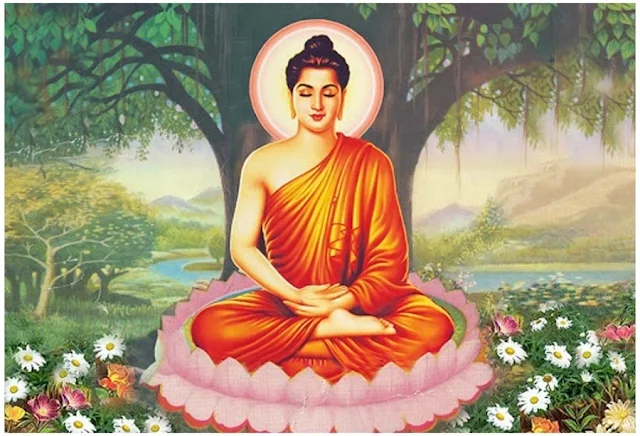Read more »
Introduction: The Invitation to a Tranquil Life
In a fast-paced world driven by ambition, technology, and constant comparison, many feel lost and overwhelmed. Yet, amidst the chaos, there exists a path carved over 2,500 years ago—a path that leads inward, toward clarity, peace, and sustainable happiness. This is the Buddhist path, not as a religion to worship, but as a living philosophy to embody.
This book is an offering—a guide to help you explore how ancient Buddhist teachings can become the foundation for a modern, joyful, and peaceful life. You will discover practical methods, real-life stories, and reflective exercises that root you in presence, help dissolve suffering, and cultivate an awakened mind.
Let this journey begin not with striving, but with stillness.
![]()
Chapter 1: The True Nature of Happiness
Happiness is often mistaken for pleasure or temporary satisfaction. We chase after possessions, praise, status, and comfort, believing they will finally bring us peace. But like sand slipping through our fingers, such happiness is fleeting.
The Buddha taught that true happiness—sukha—comes not from what we acquire, but from what we understand and release. When we see through the illusions of permanence and ego, suffering diminishes.
"There is no path to happiness. Happiness is the path." — Thich Nhat Hanh
This chapter explores:
• The difference between worldly pleasure and inner peace
• The role of contentment (santutthi) in daily life
• Letting go of attachment as a gateway to freedom
Chapter 2: Understanding Suffering and Its Roots
Suffering (dukkha) is not a punishment, but a universal truth. To deny suffering is to remain trapped in it. To face it wisely is to transform it.
Through the Four Noble Truths, the Buddha invites us to:
1. Acknowledge suffering
2. Understand its origin (craving, ignorance, and aversion)
3. Know that it can end
4. Follow the path that leads to its cessation
This chapter guides readers to identify subtle forms of suffering—restlessness, comparison, clinging—and offers tools to uproot them.
Chapter 3: Walking the Noble Eightfold Path
The Noble Eightfold Path is not a doctrine but a map of wise living. It encompasses:
• Right View
• Right Intention
• Right Speech
• Right Action
• Right Livelihood
• Right Effort
• Right Mindfulness
• Right Concentration
Each of these is a lifelong practice. When followed with sincerity, they align our actions, thoughts, and relationships with integrity and peace.
Practical examples and mindfulness practices help translate these principles into everyday habits.
Chapter 4: The Power of Mindfulness and Presence
Mindfulness (sati) is the art of returning. To return to our breath, to our body, to the moment—not to escape reality, but to embrace it fully.
In this chapter:
• Learn simple daily practices like mindful walking, breathing, and eating
• Explore how to work with distractions and restlessness
• Discover the joy hidden in ordinary moments
Mindfulness becomes a mirror—revealing where we are caught and how we can return to ease.
Chapter 5: Cultivating Compassion and Loving-Kindness
Compassion (karuna) and loving-kindness (metta) are not luxuries of the spiritual elite—they are essential nutrients of the heart.
Through meditation and action, we can:
• Dissolve resentment
• Develop empathy for ourselves and others
• Extend goodwill even to those who challenge us
This chapter includes guided meditations and real-life stories of transformation through compassion.
Chapter 6: Simplicity and the Art of Letting Go
More things do not mean more happiness. The Buddha lived simply, not because he lacked, but because he understood the burden of excess.
Here we explore:
• The beauty of a minimalist lifestyle
• How to let go of mental clutter and emotional baggage
• Practical ways to simplify your schedule, your home, and your habits
Simplicity is not deprivation—it is liberation.
Chapter 7: Creating a Peaceful Inner World in a Chaotic Outer World
The world may never be free of conflict, but your mind can be. Peace is not the absence of noise but the presence of clarity.
Learn how to:
• Set healthy boundaries
• Use conscious media consumption
• Cultivate an inner refuge through meditation
With a strong inner foundation, external storms cannot shake you.
Chapter 8: Everyday Enlightenment
Enlightenment is not a magical state reserved for monks in caves. It is a gradual awakening to the truth of things, right where you are.
• Learn how to bring awareness to routine activities
• Recognize insights in daily struggles
• Realize that the sacred is hidden in the ordinary
Conclusion: The Journey Is the Destination
There is no final arrival. Each breath, each step, each moment lived with awareness is a flowering of peace. As we walk this path, we may stumble, but the path itself is forgiving. With mindfulness, compassion, and simplicity as our companions, we build not only a happy life, but a peaceful world.
May you walk gently, love deeply, and live freely.
![]()
Appendix: Daily Practices and Reflections
• Morning mindfulness routine (5–10 minutes)
• Evening gratitude reflection
• Weekly silent sitting
• Monthly digital detox
• Loving-kindness phrases to recite




















0 Reviews